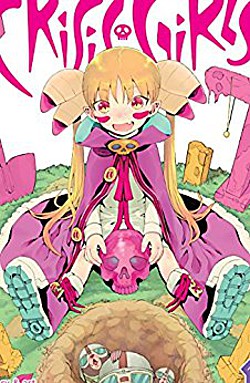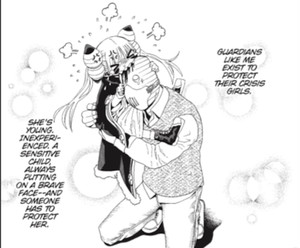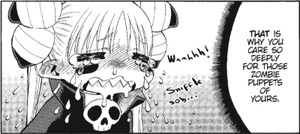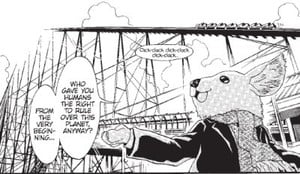The Spring 2018 Manga Guide
Crisis Girls
What's It About?
 Giant, endearingly cute creatures such as penguins and otherworldly villains like one in a jack-o-lantern mask attack Crisis City, Tokyo on a regular basis. Humanity's Last Hope is a select group of superpowered girls raised in the care of paranormal guardians. In this part of town, Gravedigger Kaede is the champion of choice, her ability to resurrect the dead and create a zombie army essential to her capacity to keep the people safe. Unfortunately, her childlike and wide-eyed motives are never that simple, as she just wants to have fun and doesn't understand why most of humankind deserves her help. Nonetheless, circumstances tend to work out so she can save the day, though the introduction of a more skilled Crisis Girl who wants to take over safeguarding her turf bruises her ego.
Giant, endearingly cute creatures such as penguins and otherworldly villains like one in a jack-o-lantern mask attack Crisis City, Tokyo on a regular basis. Humanity's Last Hope is a select group of superpowered girls raised in the care of paranormal guardians. In this part of town, Gravedigger Kaede is the champion of choice, her ability to resurrect the dead and create a zombie army essential to her capacity to keep the people safe. Unfortunately, her childlike and wide-eyed motives are never that simple, as she just wants to have fun and doesn't understand why most of humankind deserves her help. Nonetheless, circumstances tend to work out so she can save the day, though the introduction of a more skilled Crisis Girl who wants to take over safeguarding her turf bruises her ego.
Crisis Girls volume 1 (5/15/2018) is a manga by Hiroaki Yoshikawa available in paperback for $12.99 and in digital format for $9.99 from Seven Seas Entertainment and on Comixology.
Is It Worth Reading?

Amy McNulty
Rating: 4
Superhero manga are growing in popularity thanks to popular titles such as My Hero Academia and One-Punch Man, so it might be understandable to wonder what Crisis Girls can throw into the mix. The first thing is obvious: these are superheroines, supported—thus far—by male guardians, but without a macho man in sight. The second is how Crisis Girls entertains with its own comedic flair, with skillful comedic timing and original gags that keep the audience turning the pages through this fast-paced read. In some senses, this volume truly feels like a beginning, with only the barest of stakes raised by volume's end, but at least the manga isn't in danger of overusing its primary concept—the childlike, clueless superheroine who still manages to save the day—because it's a relatively short series. Still, it remains to be seen if there will be an overarching story beyond Kaede's growth as a hero and character, considering how little challenge her (amusing) antagonists have posed so far and the relatively quick resolution to her conflict with fellow Crisis Girl Toucha. The narrative is served by the introduction of two little girl villains, Marumoko and Cococha, as well as their more successfully wicked cohorts/guardians, Chihuahuano and Francfranc, so it's not always Kaede versus monsters. Both antagonists bring their own variety of screw-up to the proceedings and are responsible for some of the funniest chapters in this volume.
The art style Yoshikawa applies to Crisis Girls is as adorable as you might expect from the cheery tone and childlike quality of many of the primary players. At the same time, the macabre nature of Kaede's powers allow for some grotesque, if humorous, allies and gothic scenery. The level of detail put into the backgrounds—from spooky cemeteries to a metropolis under attack—really bring the manga to life and helps successfully juxtapose this little cheery goth girl against the vast surroundings that seem to expect too much of her.
Crisis Girls volume 1 is a delight, both funny and charming. It may seem somewhat slow to get started—especially considering the short length of the manga's run—but it never bores as it shows the day-to-day life of Crisis Girl Kaede and her long-suffering, always-supportive guardian, Okabe. Proving to be just what might be needed to fend off superhero fatigue, the first volume of Crisis Girls is off to a promising start.
 Lynzee Loveridge
Lynzee LoveridgeRating:
What if the the “dark magical girl” genre was a gag comedy instead? The results are surprisingly refreshing in Crisis Girls, a story about one “cursed” magical girl with zombie familiars who nonetheless wants nothing more than to hang out with her mummy mentor and eat cake. Sure, there's not a serious drop of plot to be found in this action-packed whirlwind of a manga; Kaede's biggest foes are a talking chihuahua and invading penguins but its stylistic silliness has its own charm and is a welcome breather from all the bleary-eyed, tortured heroines as of late.
Kaede sheds her share of tears but it's in the name of accurately depicting a simple 10-year-old girl, something creator Hiroaki Yoshikawa pulls off without ever making his lead character too whiny or obnoxious. First and foremost, Crisis Girls is interested in having a good time and that means plenty of nonsensical bad guys, explosions, and little in the way of “plot.” In one chapter, Kaede must figure out how to prioritize hostages when they are self-centered, demanding people. Another sees her resurrect the corpse of a giant penguin that was turned into a theme park so that it can swallow a sheepgirl and gangster chihuahua.
The question is really whether the above scenarios sound funny to you. This is comedy based primarily in absurdity, starring a likable child with shark teeth. Sometimes the gags can go on too long; I was pretty sick of the chihuahua chapter by the time it wrapped up but the artwork for the action sequences more than made up for it. Yoshikawa has an eye for translating quick, dynamic movement into stunning artwork while still maintaining his cartoony artstyle. If I had to compare the manga's general look to anything, it might be Soul Eater, although the characters are not quite as lanky.
At only two volumes, I'm not sure we'll get satisfactory answers to what Crisis Girls are, whether they're bred, experiments, or obtained their supernatural abilities some other way. I'd keep expectations low in the overarching plot department. Pick this one up for if you want your magical girls with a squeaky-clean heart and darker abilities all wrapped up in Saturday morning cartoon packaging.
 Rebecca Silverman
Rebecca SilvermanRating:
In some ways Crisis Girls' first volume feels like manga's biggest mashup. It has elements of Tiger & Bunny in its broadcast of the superheroine's actions, it conjures up One-Punch Man in the absurdity of its villains and the fact that it takes place in a borough of Tokyo actually named Crisis City, and the Crisis Girl herself feels as if she could have stepped out of Is This a Zombie? in her approach to being a magical girl. Throw in a few Monty Python references and you should have a sure-fire recipe for comedy.
So what went wrong? Simply put, this volume feels overstuffed with references and absurdities. It's as if the creator was trying just a little too hard to make this an over-the-top send-up of both magical girl stories and more recent superhero manga trends. While each aspect of the story works independently, as a whole they just feel like a pastry filled by an inexpert chef and bursting at the seams. It isn't bad or off-putting, but it certainly doesn't work as well as it ought to, given that both genres being lampooned are ripe for satire.
That's of course not to say that this isn't kind of fun regardless. Our particular Crisis Girl is basically a tiny necromancer – her magic calls zombies of all species to fight for her. Like any ten year old, she's very attached to her zombie friends, which makes for some good situational humor as well as giving her a particularly interesting sense of what the word “alive” means. (At one point she buries a piece of squished cake.) She's also not the world's brightest kid, which only compounds matters – the chapter where she has to figure out which hostage to save first is delightfully absurd and totally bizarre. The fact that she not only makes the right choice in the end but also has the right reasons for it shows that she does have the heart of a magical girl in there somewhere…it just gets preoccupied with things like cake.
Art-wise, this book is very crowded. There's a lot going on in each panel, and even full-page illustrations and two-page spreads feel a little too busy for easy reading. There aren't necessarily a lot of background details that make a difference in either humor or import, so it's not a style that works particularly well. Animal villains look great, however, and the demon design is fun, even if there's something that feels off about the heroine's hairstyle. (For some reason it reminds me of bugs or larva. That could just be me.) Like the story, it's a mixed bag of just right and too much, and I'll be interested to see if the story and art settle down a bit once the story hits its stride. This gets another volume, because I'm teetering on the edge of whether or not it really works as a whole.
discuss this in the forum (28 posts) |
this article has been modified since it was originally posted; see change history
back to The Spring 2018 Manga Guide
Feature homepage / archives